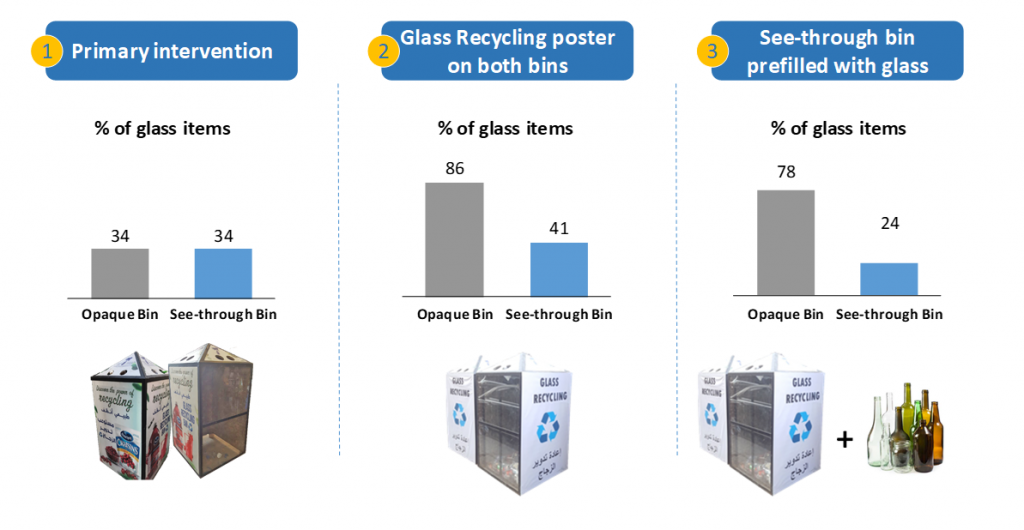Increasing the Use of Communal Glass Recycle Bins

Problem
Recycling remains an uncommon practice in Lebanon, especially when it involves glass. The process of recycling colored glass, in particular, is complex and costly. As a result, the availability of glass recycling facilities remains very low. This makes it difficult for households and businesses to find sustainable solutions for disposing of their glass waste, despite the growing awareness among citizens and civil society on the importance of recycling.[1] Indeed, ad hoc recycling initiatives are emerging around Beirut and the regions, with some offering to pick up sorted waste, for free or a small fee, while others are opening up their warehouses on the outskirts of Beirut for those wishing to dispose of their recyclable waste.[2]
One organization, in particular, has come up with an alternative option that requires less cost and effort, namely to use communal glass recycling bins scattered in various neighborhoods around the city. However, some of these bins were less utilized than others. Among those not properly utilized were the ones placed in the Hamra area of Beirut, a dynamic neighborhood packed with offices, restaurants and residential buildings. These bins also had higher levels of contamination, i.e. by non-glass items.
At stake were two challenges: 1) a lack of appropriate visual cues, and 2) a lack of social cues. With regards to the first issue, the recycling bins were placed near general waste bins, and the artwork on the sides of the bins featured a sponsored ad depicting images of plastic juice bottles. In other words, not only were the recycling bins lacking in salience, but they also gave the impression that the intended purpose of these bins was to recycle plastic. Secondly, due to non-salient and confusing messages, there was less observable traffic around the bins, potentially creating a lack of social cues (i.e. people not observing others using them).
Against this background, Nudge Lebanon ran three consecutive interventions to improve utilization of the bins and reduce contamination using visual and social cues. The first consisted of replacing the opaque front side of one of the bins with a transparent one. The second involved changing the artwork for both the opaque and see-through bins. Finally, the third consisted of prefilling the see-through bin with a small but visible amount of glass.
Intervention
In the first intervention, data was collected by visually counting the number of glass and non-glass items in the opaque and see-through bins on a daily basis. After seven days of observations, both bins revealed equally high levels of contamination, with 34% glass items in each. The opaque bin contained around 73 items in total (25 glass; 48 non-glass), while the see-through bin contained about 38 items (13 glass; 25 non-glass).
In the second intervention, the confusing original artwork was replaced with a simple and more salient “Glass Recycling ” poster (see Figure 1 below) to remove any ambiguity about the purpose of the bins, and as a result, create a positive social norm around them – particularly for the see-through one.

Figure 1 – Glass Recycling Poster
Similarly, data was collected by visually counting the number of glass and non-glass items in the opaque and see-through bins. Results revealed a drop in contamination in both, but more significantly in the opaque bin, where 86% of the newly disposed of items were glass items, as opposed to the see-through bin, which had 41% new glass items only.
It appears that the sight of contamination in the see-through bin triggered a negative social norm that crowded out any positive effects the poster may have had. That is, pedestrians who saw the non-glass items in the see-through bin presumed that it was acceptable to throw all kinds of waste in it – despite the fact that the posters clearly stated “glass recycling”.
In the third and final experiment, both bins were emptied and prefilled with a small number of glass items, only visible in the see-through bin (50 glass items), to increase the salience of its intended purpose and provide proof of use in order to create a positive norm around it.
Data was collected using the same methodology adopted in interventions I and II. The percentage of glass items in the opaque bin dropped slightly, but remained relatively high, reaching 78%, with around 120 items in total (94 glass; 25 non-glass). On the other hand, the percentage of glass items in the see-through bin remained low, dropping further to 24%. The bin had about 78 items in total (19 glass; 59 non-glass). While prefilling the see-through bin failed overall to generate a positive momentum or encourage people to act in a prosocial way, initially both bins seemed to fare equally well in attracting glass items. In other words, success was short-lived, suggesting that having even the slightest levels of contamination triggered an anti-social behavior.

Figure 2 – Summary of results of the three interventions
Conclusion
In general, all three interventions revealed high contamination rates in the see-through bin, thereby indicating a negative relationship between transparency and compliance. It appears that having signs of contamination signaled to users that it is acceptable to dispose of the wrong waste, thereby creating a negative norm around the bin. These effects might have been accentuated by the environment surrounding the bins, which was plagued with litter, graffiti, and advertisement posters.
In fact, such findings are consistent with the broken windows theory[3], which states that signs of anti-social behavior, such as contamination, littering or graffiti[4] encourages others to act in a similar manner.
It would be interesting to investigate if placing an image with a pair of watching eyes on or in proximity to the bins would increase compliance. The presence of such images in the environment has been shown to promote prosocial behavior in various contexts. For instance, it has been used to reduce littering[5], increase compliance with donation requests[6][7], increase contributions to an honesty box[8] and reduce theft[9].
To conclude, the evidence from this study confirms the fact that context matters. While interventions using transparent donation boxes, tip jars, and recycling bins may have been successful at eliciting higher levels of compliance in select places, these interventions do not seem to be adaptive to the context of the Hamra area in Beirut – possibly due to a weak sense of community and cooperative behavior.
Endnotes
[1] The citizens finding solutions to Lebanon’s chronic waste crisis. France 24. Retrieved from http://www.france24.com/en/20180419-focus-lebanon-waste-garbage-crisis-pollution-corruption-health-civil-society-solutions
[2] Yan, V. (2018, April 27). Does Beirut have a sustainable recycling plan? The Daily Star. Retrieved from https://www.pressreader.com
[3] Wilson, J. Q. Kelling, G. L. (2003). The police and neighborhood safety: Broken windows.
[4] Coghlan, A. (2008, November 21). Graffiti and litter lead to more street crime, New Scientist. Retrieved from https://www.newscientist.com.
[5] Ernest-Jones, M., Nettle, D., Bateson, M. (2011). Effects of eye images on everyday cooperative behavior: a field experiment. Evolution and Human Behavior, 32(3), 172-178.
[6] Oda, R., Ichihashi, R. (2016). Effects of Eye Images and Norm Cues on Charitable Donation: A Field Experiment in an Izakaya.
[7] Powell, K. L., Roberts, G., Nettle, D. (2012). Eye images increase charitable donations: Evidence from an opportunistic field experiment in a supermarket. Ethology, 118(11), 1096-1101.
[8] Bateson, M., Nettle, D., Roberts, G. (2006). Cues of being watched enhance cooperation in a real-world setting. Biology letters, 2(3), 412-414.
[9] Metcalfe, J. (2013, April 29). Posters of Angry Eyes Actually Scare Off Bike Thieves. City Lab. Retrieved on https://www.citylab.com.



